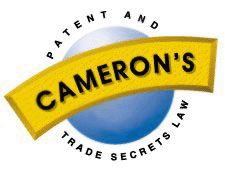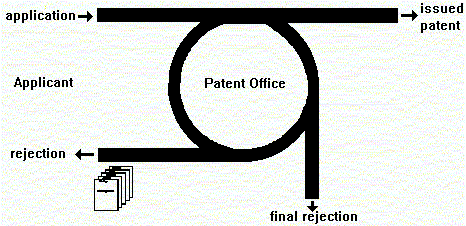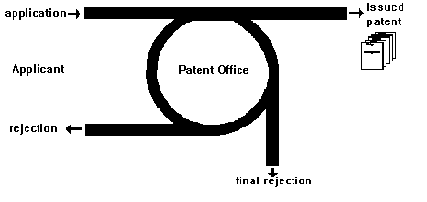
Examination of the Patent Application
copyright 1997, 1998 Donald M. Cameron,
Aird & BerlisCameron's Canadian Patent & Trade Secrets Law: Home Page; Index
 |
Examination of the Patent Application
|
Table of Contents |
|
| The Request for Examination
Disclosure of Information to the Examiner |
Abandonment & Reinstatement
Final Rejection and Rights of Appeal |
Examination is the process by which the Patent Office examines the application to determine the patentability of the invention. It is neither free nor automatic.
Examination is initiated by filing with the Patent Office a Request for Examination together with the necessary fee [Patent Act, s. 35(1)]. The government fee for requesting examination is $200.00 for a small entity; $400.00 for a large entity [Tariff of Fees, Schedule II, Part I, item 3].
Examination must be requested within a certain time period:
or else the application will be treated as abandoned .
If the application was divided from a parent application, examination must be requested within the same time period as the parent application, or within 6 months of filing the divisional, whichever is later [Patent Rules, s. 150(2) and 96(2)]. The Commissioner may notify the Applicant to require the filing of a request for examination [Patent Act, s. 35(2)].
The Request for Examination can be made by the Applicant or by any other party and must contain the necessary information for the Patent Office to recognize what application is being requested to be examined [Patent Rules, s. 149 and 95).
Where a timely Request is not filed, and the application goes abandoned [Patent Act, s. 73(1)(d) and 73(1)(e)], the Patent Office may reinstate the application upon Request for Reinstatement, Request for Examination and payment of the prescribed fee of $200.00 [Patent Act, s. 73(3), Tariff, Schedule II, Part I, item 7)].
The application is usually referred to Examiners who are familiar with the particular technology of the invention.
The invention described and claimed in the invention is compared by the Examiner in the Patent Office, to the prior art.
The prior art comes from a search done by the Examiner, prior art cited in foreign Patent Offices during examination of corresponding applications and/or documentary materials supplied by anyone to the Patent Office under a Protest [Patent Act, s. 34.1]. In the United States, the Applicant has the obligation to disclose relevant prior art to the U.S. Patent Office.
To obtain his or her own prior art, the Examiner reviews patents or patent applications on file in the same or related areas. There is an international classification system for categories of inventions which aids in searching.
There are computerized databases of issued patents and technical and scientific articles which can be searched using "keywords". Caution must be exercised when selecting the appropriate keywords since different words may be used to describe the same kind of invention.
An Examiner can formally ask an Applicant to provide copies of prior art cited in foreign corresponding applications [Patent Rules, s. 29]. Where, for example, the United States Patent Office has already done a prior art search and cited prior art against the corresponding U.S. patent application, the job of the Canadian Examiner is made easier by invoking Patent Rule s.29: the Canadian Examiner gets the benefit of the search done by the U.S. Patent Offices. The Examiner can also ask for particulars of interference proceedings [Patent Rules, s. 29(1)(c)].
The Examiner can also ask for information concerning the first publication of the invention or the first patent for the invention [Patent Rules, s. 29(2)]. It is usually in the Applicant’s interest to report the successful issuance of a corresponding patent as it may encourage the Patent Office to issue a patent of similar scope.
If the Applicant cannot supply the information requested, the Applicant must state why the information is not forthcoming [Patent Rules, s. 29(3)].
Normally, an application will proceed along with the other applications, in order of its receipt at the Patent Office.
The queue can be "jumped" by requesting in writing advanced examination on the ground that a failure to advance the application will likely prejudice the rights of that person [Patent Rules, s. 28]. Evidence must be supplied setting out the facts upon which the request for advancement is based. A government fee of $100.00 is charged [Patent Rules, Schedule II, Part I, Item 4].
The request for advancement must be preceded by, or accompanied by, a request for examination of the application. The application must be complete, open to public inspection and have met the formalities (MPOP, s. 13.03).
After reviewing the application, the Examiner may conclude that the Applicant is required under the Patent Act or Patent Rules to amend the application and will issue a letter to the Applicant setting out the requirements. The letter is referred to as an Office Action [Patent Rules, s. 30(2)].

responses to Office Actions
Applicants are obliged to reply to an office action within 6 months to avoid abandonment of the application. They must reply in good faith in an attempt to answer the objection to advance the application to allowance [Patent Act, s. 73(1)(a)]. This obligation is usually performed by making the change requested by the Examiner or by arguing with the Examiner that the requirement is not necessary and the objection should be withdrawn.
An application may be amended before it issues either voluntarily or to overcome an objection made by an Examiner in an Office Action [Patent Act, s. 38.2].
No amendment can be made to the specification that describes matter not reasonably to be inferred from the specification or drawings [Patent Act, s. 38.2(2)].
Every amendment must be accompanied by a statement explaining the nature and purpose of the amendment so as to satisfy the Examiner that it is permissible. [Patent Rules, s. 34].
Amendments must be made by providing new pages replacing those altered by the amendment [Patent Rules, s. 34].
Where there are two or more inventors, and one refuses to assist in the prosecution of the application, or cannot be found, the remaining inventors can proceed without the reluctant or missing inventor. They must satisfy the Commissioner as to the facts, usually by affidavit. The patent will issue to the remaining inventors [Patent Act, s. 31(1)].
The situation is similar where too many Applicants were named. The "superfluous" inventor/Applicant can retire and the application will proceed with the remaining Applicants. Affidavit evidence must be submitted to the Commissioner [Patent Act, s. 31(3)].
Where not enough Applicants were named, the further Applicants can be joined by satisfying the Commissioner that they should be joined and that their omission was due to inadvertence or mistake and not for the purpose of delay [Patent Act, s. 31(4)].
Where joint Applicants cannot agree on how to proceed with an application, or where someone has agreed to assign a patent, when granted, and has not proceeded with the application, the Commissioner can allow the other person to proceed with the application and can grant the patent to that other person [Patent Act, s. 31(2)].
There are no provisions for the replacement of a sole applicant.
No amendment can be made to the drawings that adds matter not reasonably to be inferred from the specifiaction or drawings as originaly filed, except in so far as it is admitted in the specification that the matter is prior art [Patent Act, s. 38.2(3)].
A patent is supposed to protect one invention [Patent Act, s. 36(1)]. In Canada, a patent can contain apparatus and method claims. No division is required where a patent application claims:
In the United States, separate patents are often obtained for devices and methods.
Where a patent application discloses and claims more than one invention, the application must be limited to one invention and the applicant may divide out the other invention [Patent Act, s. 36(2)].
Both the original application and the divisional application, share a common filing date, but the Patent Office requires a second set of fees in respect of the divisional application [Patent Act, s. 36(4)].
New matter, which is intimately associated with the matter described in the existing disclosure, can be made the subject of a Supplementary Disclosure [Pre Oct.1, 1989 Patent Rules, s. 53] (so long as the application has not yet been allowed [Pre Oct.1, 1989 Patent Rules, s. 55]. Only one supplementary disclosure is allowed per application [Pre Oct.1, 1989 Patent Rules, s. 56].
The supplementary disclosure forms part of the patent as issued and is taken as having been filed on the date the amendment was applied for [Pre Oct.1, 1989 Patent Rules, s. 53].
If there are claims in an application that are fully supported only by he supplementary disclosure, then they are identified as such and are separated from other claims in the application [Pre Oct.1, 1989 Patent Rules, s. 54]. There must be other claims supported by the original disclosure [Pre Oct.1, 1989 Patent Rules, s. 57].
Amendments (other than clerical errors) cannot be made after allowance unless:
The patent application is laid open for public inspection on the earliest of the following dates:
(a) 18 months from its Canadian filing date;
(b) 18 months from its priority date (if it has one); or
(c) earlier when requested by the Applicant [Patent Act, s. 10(2)].
A request for priority may be withdrawn to create a later laying-open date.
Third parties can object to the grant of a patent by means of a protest. The third party files prior art and explains its pertinence to the application [Patent Act, s. 34.1].
The third party’s protest is acknowledged by the Patent Office, but it is not given information as to the action taken on it [Patent Rules, s. 10].
Under the "old" Patent Act, (prior to October 1, 1989) the patent was to be granted to the Applicant who was the first-to-invent. Where there were two applications for the same invention, or overlapping inventions:
where each application contained one or more claims defining substantially the same invention; or
where one or more claims from one application described the invention disclosed in the other application,
the Commissioner of Patents would declare that a conflict existed. A mini-trial within the Patent Office would follow, to determine who was the first inventor (Pre-Oct. 1, 1989 Patent Act s. 43).
The current first-to-file system awards the patent to the first person to apply to patent the invention, thus doing away with the need for conflict proceedings.
If the Applicant does not satisfy the Examiner’s objection, then the Examiner can issue a second office action on the same ground.
If the Examiner makes the action a Final Action, and the Applicant amends the application or provides acceptable arguments that the application should be allowed, the rejection is withdrawn [Patent Rules, s. 30(5)].
If the rejection is not withdrawn, then the application is forwarded to the Patent Appeal Board and the Applicant is given an opportunity to be heard [Patent Rules, s. 30(6), MPOP 21.04]
The Patent Appeal Board’s findings are given to the Commissioner for consideration [MPOP, s. 21.06].
After the Applicant has received a Final Action, the application cannot be amended other than:
When the application is found to be allowable, a notice of allowance is given to the Applicant together with notice of the deadline for paying the final fee [Patent Rules, s. 30(1)].
If after allowance, the Commissioner finds that the application should not be allowed, he will withdraw the notice of allowance and notify the Applicant, returning any final fee [Patent Rules, s. 30(7) & 4(10)(a)].
The patent will issue between approximately 6 and 12 weeks from the date of payment of the final fee.

All documents evidencing the title to the invention should be filed on or before the day the final fee is paid so that the patent issues to the proper owner [Patent Rules, s. 41]. The patent will issue to the inventor and his legal representative (in other words the party having title to the patent) according to their interests as evidenced in documents filed (and acceptable for registration) as of the day the final fee is paid. In the case of joint Applicants, the patent is granted in the name of all the Applicants [Patent Act, s. 31(5)]. The person to whom the patent issues is referred to as the Grantee or Patentee.
The examination process can be re-visited by a procedure called re-examination. Re-examination is limited to providing the Patent Office with:
Unless the re-examination is requested by the Patentee, the request for re-examination and the prior art must be submitted in duplicate [Patent Rules, s. 45].
After receiving a request for re-examination from a third party, the Commissioner sends a copy of it to the Patentee [Patent Act, s. 48.1(3)].
The Commissioner establishes a Re-examination Board (with at least three members, at least two of whom are Patent Office employees) who will determine the re-examination [Patent Act, s. 48.2(1)] within three months of the request [Patent Act, s. 48.2(2)]. The Board must determine whether the request raises "a substantial new question of patentability affecting any claim of the patent" [Patent Act, s. 48.2(2)].
If the Board finds that there is no substantial new question raised, they advise the person who requested re-examination. The decision of the Board is final and is not subject to appeal or review by any Court [Patent Act, s. 48.2(3)].
If the Board finds that there is a substantial new question raised by the request, the Board so notifies the Patentee together with their reasons [Patent Act, s. 48.2(4)]. The Patentee may, within 3 months of the Board’s notice submit to the Board a Reply setting out submissions as to the patentability of the claim of the patent in issue [Patent Act, s. 48.2(5)]. The Patentee may propose an amendment to the patent or any new claims, so long as nothing is done to enlarge the scope of a claim [Patent Act, s. 48.3(2)].
Upon receiving the Reply (or after 3 months, if no Reply is received), a Re-examination Board will commence a re-examination [Patent Act, s. 48.3(1)].
The re-examination proceeding must be completed within 12 months of the commencement of the re-examination [Patent Act, s. 48.3(3)].
The final decision of the Re-examination Board takes the form of a certificate. The certificate:
A copy of the certificate is attached to the patent and made part of it by reference. A copy is also mailed to the Patentee [Patent Act, s. 48.4(2)].
The decision of the Re-examination Board can be appealed to the Federal Court [Patent Act, s. 48.5(1)] within 3 months from the date the certificate is mailed to the Patentee [Patent Act, s. 48.5(2)].
The certificate gives the change retroactive effect. Where the claim is canceled, the claim is to be treated as if it had never been granted. Other claims remain unaffected. New or amended claims are to be treated as if they issued on the date of the certificate, for the unexpired term of the patent [Patent Act, s. 48.4(3)].
The Reissue procedure is used to fix certain types of mistakes in issued patents. The Reissuance must be sought within 4 years from the date of issuance of the patent [Patent Act, s. 47(1)]. The Patentee must surrender the patent to the Commissioner and pay a fee [Patent Act, s. 47(1)] of $800.00 [Patent Rules, Schedule II, Item 12]. The Commissioner will cause a new patent to issue, with an amended description and specification, which will last for the unexpired term of the original patent [Patent Act, s. 47(1)].
To be entitled to a reissuance, the Patentee must show that the patent is defective or inoperative by reason of:
- and -
When the reissue patent issues, the original patent is surrendered. A revised claim of the reissue patent has the effect as if they had been originally filed in that form before the issuance of the earlier patent [Patent Act, s. 47(2)]. The reissuance has no effect on claims which were not amended - they constitute a continuation and have effect from the date of the original patent [Patent Act, s. 47(2)].
The mistake can be that of the patent agent where he failed to make the Canadian patent application the same as the corresponding American application (Mobil Oil at p. 10).
Whenever, by any mistake, accident or inadvertance, and without any wilful intent to defraud or mislead the public, a Patentee has a patent that:
the Patentee may make a disclaimer of such parts that the Patentee does not claim to hold [Patent Act, s. 48(1)].
The disclaimer is made by submitting a completed copy of Form 2, Schedule I [Patent Rules, s. 44] accompanied by the fee [Patent Act, s. 48(1)] of $100.00 [Patent Rules, Schedule II, item 13].
Following the making of a disclaimer, the patent is valid for such material and substantial part of the invention as is not disclaimed [Patent Act, s. 48(6)]. The disclaimer does not affect any pending action [Patent Act, s. 48(4)].
Return to:
Cameron's Canadian Patent & Trade Secrets Law: Home Page; Index
Cameron's IT Law: Home Page; Index